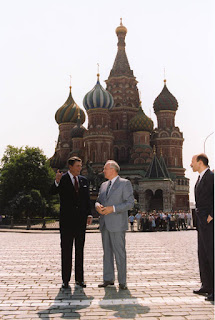It went into effect on January 1, 1987, and permitted on-site challenge inspections by small, four-person teams of military officers of large-scale, scheduled military exercises. If a military force of more than 17,000 took part in an exercise, the participating states had to provide notification 42 days in advance and issue an invitation to all of the signatories to send an on-site inspection team to observe the exercise.
There was no right of refusal. However, the agreement limited nations that were not members of the same alliance (i.e., NATO or the Warsaw Pact) to a single challenge inspection each per year. This provision limited the number of inspections. In 1987, the first full year of the Stockholm Document, there were only five on-site challenge inspections. The United States conducted a single on-site inspection under the agreement in l987. On-Site Inspections Under the Intermediate-range Nuclear Forces Treaty
Speak the Truth about Democratic Erosion in Russia. Just weeks before assuming her responsibilities as National Security Adviser in 2000, Condoleezza Rice wrote about the deleterious consequences of not speaking honestly about Russia’s internal problems: “The United States should not be faulted for trying to help. But, as the Russian reformer Grigori Yavlinsky has said, the United States should have ‘told the truth’ about what was happening [inside his country].”
She then attacked “the ‘happy talk’ in which the Clinton administration engaged.” Dr. Rice’s message is even truer today. The aim of speaking the truth is not to lecture Putin or try to persuade him to change his ways, but rather to demonstrate solidarity with Russian human rights and democracy activists.
Direct personal engagement of Russian democratic activists also matters. When Ronald Reagan traveled to the Soviet Union in May 1988, he discussed arms control and regional conflicts with Soviet leader Mikhail Gorbachev. Yet, Reagan did not let his friendship and cooperation with Gorbachev overshadowed his other agenda while in town – human rights. Speaking in Helsinki the day before entering the Soviet Union for the first time, Reagan proclaimed that “There is no true international security without respect for human rights…
The greatest creative and moral force in this world, the greatest hope for survival and success, for peace and happiness, is human freedom.” During his stay in the Soviet capital, Reagan echoed this theme in action and words many times, whether in his speech to students at Moscow State University or in a luncheon with nearly a hundred human rights activists at the American ambassador’s residence. Reagan did not simply show up for a photo op with these enemies of the Soviet dictatorship.
He ordered that the ambassador’s finest silverware and linens be used to accord these human rights activists the same respect that he showed for his Soviet counterpart. American officials must again adopt a similar strategy of using meetings with Russian democratic and human rights activists to help elevate attention to their cause and help prevent these brave people from further harassment from the Russian government. Russia: Rebuilding the Iron Curtain
Text Credits :
house.gov: Generally speaking, works created by U.S. Government employees are not eligible for copyright protection in the United States. See Circular 1 "COPYRIGHT BASICS" from the U.S. Copyright Office.
1. DTRALink is provided as a public service by the Defense Threat Reduction Agency, Corporate Communication.
2. Information presented on DTRALink is considered public information and may be distributed or copied. Use of appropriate byline/photo/image credits is requested.
IMAGES FROM THE REAGAN LIBRARY ARCHIVES (Selected by the Reagan Library Audiovisual Staff)
These photographs were selected through a combination of criteria: popularity, historical significance and composition. No scanned image has been cropped but please note that the on-screen color and quality may vary from an actual print. The over 600 selected images represented here are only a small portion of the over 1.5 million photographs available. All the photographs are in the public domain and may be credited "Courtesy Ronald Reagan Library."
Technorati Tags: President Ronald Reagan and Moscow Summit or General Secretary Mikhail Gorbachev and Public Domain Clip Art and Nanotechnology Today or Republican National Convention Blog















No comments:
Post a Comment